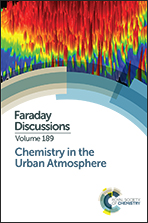Oxidative potential of size-fractionated atmospheric aerosol in urban and rural sites across Europe†
Abstract
In this study we applied several assays, an in vitro rat alveolar macrophage model, a chemical ROS probe (DTT, dithiothreitol), and cytokine induction (TNFα) to examine relationships between PM-induced generation of reactive oxygen species (ROS) and PM composition, using a unique set of size-resolved PM samples obtained from urban and rural environments across Europe. From April–July 2012, we collected PM from roadside canyon, roadside motorway, and background urban sites in each of six European cities and from three rural sites spanning the continent. A Hi-Vol sampler was used to collect PM in three size classes (PM>7, PM7–3, PM3) and PM was characterized for total elements, and oxidative activity quantified in unfiltered and filtered PM extracts. We measured a remarkable uniformity in air concentrations of ROS and especially DTT activity across the continent. Only a 4-fold difference was documented for DTT across the urban sites and a similar variance was documented for ROS, implying that chemical drivers of oxidative activity are relatively similar between sites. The ROS and DTT specific activity was greater at urban background sites (and also rural sites) than at urban canyon locations. PM3 dominated the size distribution of both ROS activity (86% of total) and DTT activity (76% of total), reflecting both the large contribution of PM3 to total PM mass levels and importantly the higher specific oxidative activity of the PM3 in comparison with the larger particles. The soluble fraction of total activity was very high for DTT (94%) as well as for ROS (64%) in the PM3. However in the larger PM size fractions the contributions of the insoluble components became increasingly significant. The dominance of the insoluble PM drivers of activity was particularly evident in the TNFα data, where the insoluble contribution to cytokine production could be 100-fold greater than that from soluble components. ROS and DTT activity were strongly correlated in the PM3 (r = 0.93), however oxidative activity was not correlated with any measured inorganic element in this size cut. In contrast, significant correlations of both ROS and DTT oxidative activity with specific groups of chemical elements were documented in the larger PM size fractions.
- This article is part of the themed collection: Chemistry in the Urban Atmosphere

 Please wait while we load your content...
Please wait while we load your content...